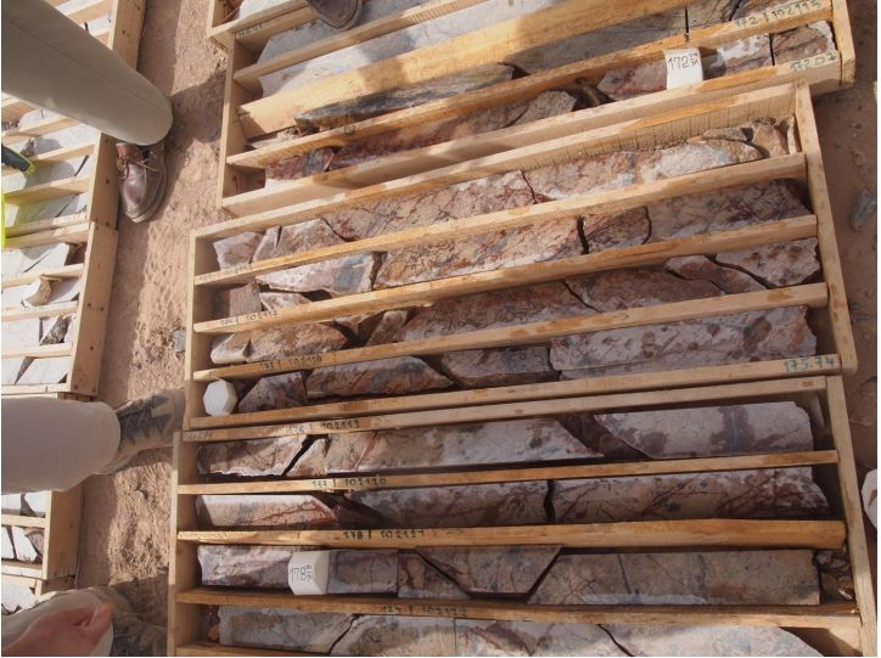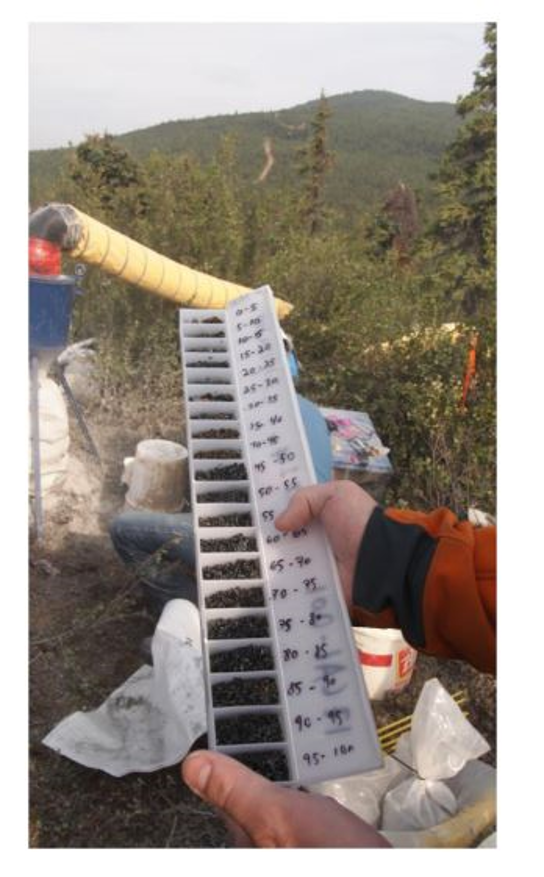
Gwen Preston – “Explaining Exploration: What Is Drilling?”

Ask any seasoned mineral explorer and they will tell you that there is no exploration activity more valuable than drilling. Drill results provide the most information about what lies beneath. As such, they have a monumental impact on share value and determine the direction a project takes. 8
But what do we actually do to get rock out of the ground? We drill, in one of two ways.
Drilling is the most expensive part of an exploration program, so companies focus their exploration dollars on the most promising targets on their property. Drill targets are located and prioritized using information from geological maps, geophysical modeling, sampling of surface materials, previous drilling, and probably a healthy dose of intuition. (I’ll explain each of these inputs, other than intuition, as this series progresses!) The exact location of a drill hole may also be modified by environmental concerns, permit requirements, and land access.
The type of drill rig selected for the job depends on conditions, budget and timing. Is the hole being collared – started – in steep, forested terrain, in the middle of the desert, or on a frozen lake? What type of rock is expected to be encountered down the hole? What is the target depth? Budget and time constraints and industry cycles play a role, too. In boom times, drills in busy exploration areas are thin on the ground while in slow times, drill companies are begging to be put to work!
Diamond Drilling
To be clear, diamond drilling isn’t drilling for diamonds (although this drilling method can be used to help find diamond deposits). It’s drilling using diamonds to cut a core of rock.
A diamond drill rig positioned at the surface sends a quickly rotating drill bit embedded with diamonds bores down into the earth to retrieve a core of rock about as thick as your arm. Water is required to keep the spinning drill bit cool as it bores through the rock.
The diamond-studded drill bit spins at the end of a rod – a hollow steel pipe about 3 meters (10 feet) long. Drill crews add rods as the hole moves deeper, screwing a string of rods together along the length of the hole. As it goes, a solid column of rock moves up the drill pipe to be recovered by the drill crew.
The size and type of drill bit use and the diameter of core recovered depends on the rock types being drilled, and often the cost! The goal is to recover all the rock within the core so as to get a representative sample, which in turn provides more information to make a reliable mineral resource model.
Typically, mineral exploration projects will drill 75.7 mm (3 in) holes to retrieve 47.6 mm (1-7/8 in) core, known as ‘NQ’ size, or slightly thicker 96 mm (3-3/8 in) holes to retrieve 63.5 mm (2-1/2 in) core, known as ‘HQ’ size. A much smaller ‘PQ’ size is available, along with the whopper ‘BQ’ size. Really deep holes will often start out thicker near the surface and use a thinner barrel as the hole proceeds deeper.
The retrieved core is cracked into shorter lengths and stored in core boxes, typically shallow wooden boxes about 150 cm by 30 cm with 3 to 6 compartments running lengthways. Depth markers are inserted to track the depth. You’ve likely seen photos of core boxes, as they’re reasonably common in company press releases

Geologists then log the rock core. They examine the core for veins and other structures, assess rock type, and note if and how the rock has been altered from its original state. Drill cores are always then cut in half longways so that half can be stored while the other half is sent for analysis. It may be pulverised to powder for geochemical analysis or sliced into thin sections for examination under a microscope.
RC Drilling
In contrast to the lovely smooth core of solid rock you get from diamond drilling, a faster and cheaper form of drilling, called Reverse Circulation or RC drilling, produces a tray full of small rock chips.
Rather than using a spinning, diamond-studded bit to bore through the rock, RC drilling uses a pneumatic, hammering action and compressed air to bust through the rock to return rock chips and powder back to the surface. No core is retrieved.
To retrieve the pulverised rock material, an RC rig forces air down the center of the pipe, which then pushes the material up the outside of the borehole. At the surface, the drillers put the chips in bags and/or place them in chip trays, which are long, thin plastic cases with a row of half-cup size sections to hold a representative sample of a depth interval, usually about 1 meter.

Pros and Cons In general, RC drilling is cheaper and faster. RC rigs are smaller and more transportable and require less water than diamond drilling. So RC rigs are great for rugged and remote places or protected areas where water is scarce or unavailable.
However, RC drills carry two big limitations: RC samples convey very little structural information and RC drills can’t go as deep as diamond drills.
Diamond drilling is more expensive. A typical diamond drill program probably costs north of $200 per meter, depending on the rock type, the expertise of the drillers, the drill location, and much more. It can also be painfully slow. Grinding through the rock and recovering a complete core takes time and issues often arise. It can take hours or even days to pull up the entire rod string to change the bit when it wears out, or the hole can simply get lost in ‘bad ground’.
The bottom line is that diamond drilling retrieves a solid, almost continuous core of rock from the ground and upon investigation can provide more valuable information than RC. It is expensive and slow but is more accurate and can reach deeper. But RC drilling is important in reaching difficult areas and its chip samples still let you know the grade, as long as sampling is done correctly.
MORE or "UNCATEGORIZED"
Koryx Copper Intersects 338.61 Meters At 0.38% Cu Eq Including 230.61 Meters At 0.45% Cu Eq and Multiple 2 Meters Intersections Over 1.00% Cu Eq
Significant copper and molybdenum intersections include: HM09: 13... READ MORE
Aya Gold & Silver Reports Q1-2024 Results; Maintains Guidance; Zgounder Expansion on Track
Aya Gold & Silver Inc. (TSX: AYA) (OTCQX: AYASF) is pleased t... READ MORE
Silver Mountain Delivers Positive Preliminary Economic Assessment For Its Reliquias Project, Peru; Pre-Tax NPV 5% Of C$107 million, Pre-Tax IRR Of 57%, And Payback Of 1.8 Years
Key Highlights – Preliminary Economic Assessment Pre-Tax Net Pr... READ MORE
ARIS MINING REPORTS Q1 2024 RESULTS WITH SEGOVIA GENERATING $13.8 MILLION IN OPERATING CASH FLOW
Aris Mining Corporation (TSX: ARIS) (NYSE-A: ARMN) announces its ... READ MORE
Orla Mining Reports First Quarter 2024 Results
Orla Mining Ltd. (TSX: OLA) (NYSE: ORLA) announces the results fo... READ MORE










